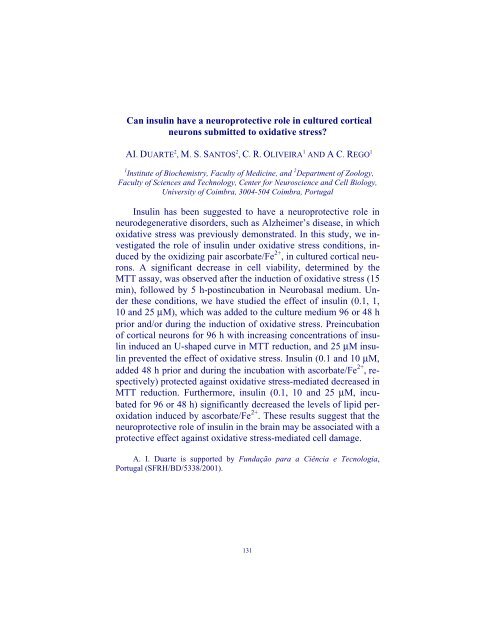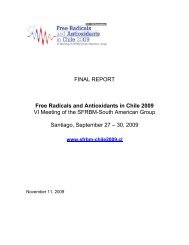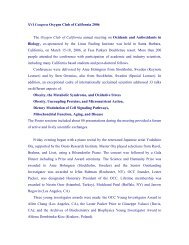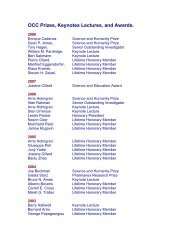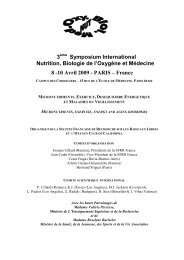oxidants and antioxidants in biology - Oxygen Club of California
oxidants and antioxidants in biology - Oxygen Club of California
oxidants and antioxidants in biology - Oxygen Club of California
Create successful ePaper yourself
Turn your PDF publications into a flip-book with our unique Google optimized e-Paper software.
Can <strong>in</strong>sul<strong>in</strong> have a neuroprotective role <strong>in</strong> cultured cortical<br />
neurons submitted to oxidative stress?<br />
AI. DUARTE 2 , M. S. SANTOS 2 , C. R. OLIVEIRA 1 AND A C. REGO 1<br />
1 Institute <strong>of</strong> Biochemistry, Faculty <strong>of</strong> Medic<strong>in</strong>e, <strong>and</strong> 2 Department <strong>of</strong> Zoology,<br />
Faculty <strong>of</strong> Sciences <strong>and</strong> Technology, Center for Neuroscience <strong>and</strong> Cell Biology,<br />
University <strong>of</strong> Coimbra, 3004-504 Coimbra, Portugal<br />
Insul<strong>in</strong> has been suggested to have a neuroprotective role <strong>in</strong><br />
neurodegenerative disorders, such as Alzheimer’s disease, <strong>in</strong> which<br />
oxidative stress was previously demonstrated. In this study, we <strong>in</strong>vestigated<br />
the role <strong>of</strong> <strong>in</strong>sul<strong>in</strong> under oxidative stress conditions, <strong>in</strong>duced<br />
by the oxidiz<strong>in</strong>g pair ascorbate/Fe 2+ , <strong>in</strong> cultured cortical neurons.<br />
A significant decrease <strong>in</strong> cell viability, determ<strong>in</strong>ed by the<br />
MTT assay, was observed after the <strong>in</strong>duction <strong>of</strong> oxidative stress (15<br />
m<strong>in</strong>), followed by 5 h-post<strong>in</strong>cubation <strong>in</strong> Neurobasal medium. Under<br />
these conditions, we have studied the effect <strong>of</strong> <strong>in</strong>sul<strong>in</strong> (0.1, 1,<br />
10 <strong>and</strong> 25 µM), which was added to the culture medium 96 or 48 h<br />
prior <strong>and</strong>/or dur<strong>in</strong>g the <strong>in</strong>duction <strong>of</strong> oxidative stress. Pre<strong>in</strong>cubation<br />
<strong>of</strong> cortical neurons for 96 h with <strong>in</strong>creas<strong>in</strong>g concentrations <strong>of</strong> <strong>in</strong>sul<strong>in</strong><br />
<strong>in</strong>duced an U-shaped curve <strong>in</strong> MTT reduction, <strong>and</strong> 25 µM <strong>in</strong>sul<strong>in</strong><br />
prevented the effect <strong>of</strong> oxidative stress. Insul<strong>in</strong> (0.1 <strong>and</strong> 10 µM,<br />
added 48 h prior <strong>and</strong> dur<strong>in</strong>g the <strong>in</strong>cubation with ascorbate/Fe 2+ , respectively)<br />
protected aga<strong>in</strong>st oxidative stress-mediated decreased <strong>in</strong><br />
MTT reduction. Furthermore, <strong>in</strong>sul<strong>in</strong> (0.1, 10 <strong>and</strong> 25 µM, <strong>in</strong>cubated<br />
for 96 or 48 h) significantly decreased the levels <strong>of</strong> lipid peroxidation<br />
<strong>in</strong>duced by ascorbate/Fe 2+ . These results suggest that the<br />
neuroprotective role <strong>of</strong> <strong>in</strong>sul<strong>in</strong> <strong>in</strong> the bra<strong>in</strong> may be associated with a<br />
protective effect aga<strong>in</strong>st oxidative stress-mediated cell damage.<br />
A. I. Duarte is supported by Fundação para a Ciência e Tecnologia,<br />
Portugal (SFRH/BD/5338/2001).<br />
131


